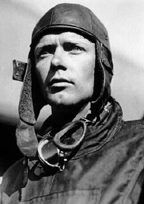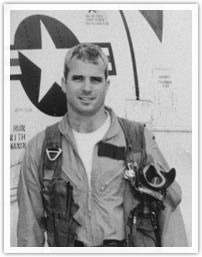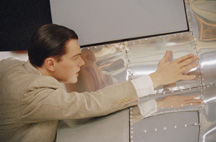High In the Sunlit Silence
The enduring glamour of aviation
Reason , December 20, 2004
 The new movie about Howard Hughes could have had any number of titles, from the simple Hughes to the inflation-ignoring America's First Billionaire. But no alternative would have the magical attraction of The Aviator.
The new movie about Howard Hughes could have had any number of titles, from the simple Hughes to the inflation-ignoring America's First Billionaire. But no alternative would have the magical attraction of The Aviator.
From the days of biplanes and silk scarves, the aviator has been the archetype of masculine glamour. Aviators have personified national ideals, from French elan to Soviet party discipline. They've inspired lust and admiration. They've turned sunglasses and short, utilitarian leather jackets into fashion statements. "Glamour boys," the press called Royal Air Force fliers between the wars, and the nickname stuck through their finest hour.
Charles Lindbergh's glamour was once as potent as any movie star's, powerful enough, imagines Philip Roth in his latest novel, to topple Franklin Roosevelt. When George W. Bush stepped on to an aircraft carrier in a flight suit, he wrapped himself in the aviator's aura. So did Sen. John McCain when his 2000 presidential campaign used a portrait of the candidate as a handsome young flier.
If glamour is, to quote from a fashion blurb, "all about transcending the everyday," what could be more transcendent than flight itself? Even today, when commercial air travel has become a dull yet stressful routine, a photo of a jet in the sky still has a glamorous power. It promises to transport us out of the everyday, to take us away to some better place.
 Director Martin Scorsese, in an interview with The Boston Globe, recalls reading the Aviator script and "imagining Hughes up there in the clouds, flying over the world, that is transcending the mortal self." His movie is all about transcendence, aspiration, and illusion. It portrays glamour for a cynical, media-savvy age.
Director Martin Scorsese, in an interview with The Boston Globe, recalls reading the Aviator script and "imagining Hughes up there in the clouds, flying over the world, that is transcending the mortal self." His movie is all about transcendence, aspiration, and illusion. It portrays glamour for a cynical, media-savvy age.
For centuries, glamour was literal magic, a malicious deception created by witches. In the 20th century mass media turned the magic into a metaphor. Glamour became the imaginative process an audience undergoes in the presence of a special combination of mystery and grace: "Men want to be him, and women want to be with him" (or vice versa). Glamour in this sense may have always existed, but only in the age of mass communication did it, like charisma, become so commonly experienced that it required a special name.
 From the beginning, publicists depicted aviators as glamorous--larger yet simpler than life and aloof from earthbound mortals. Discussing a 1908 French profile, the first of a living rather than fictional aviator, historian Robert Wohl writes that "it ascribes to Wilbur Wright many of the characteristics and qualities that would later become identified with countless other famous fliers," among them: "the unusual eyes; self-reliance; determination; attention to detail; extraordinary patience; an artisan-like dedication to work; loneliness; genius; indifference to the superficial emotions of the masses."
From the beginning, publicists depicted aviators as glamorous--larger yet simpler than life and aloof from earthbound mortals. Discussing a 1908 French profile, the first of a living rather than fictional aviator, historian Robert Wohl writes that "it ascribes to Wilbur Wright many of the characteristics and qualities that would later become identified with countless other famous fliers," among them: "the unusual eyes; self-reliance; determination; attention to detail; extraordinary patience; an artisan-like dedication to work; loneliness; genius; indifference to the superficial emotions of the masses."
A decade later, the daring exploits of World War I aces provided an inspiring contrast to the bloody, muddy tedium of trench fighting. "Aces exemplified more purely than any other figure of their time what it meant to be a man," writes Professor Wohl in A Passion for Wings: Aviation and the Western Imagination, 1908-1918 (Yale University Press, 1994). That most aces died young only added to their allure, preserving them as ageless icons.
Taking national identification to an extreme, Soviet propaganda posters turned aviators into literal icons, appropriating the conventions of Russia's traditional religious art. Instead of Christ ringed by a mandorla, or almond-shaped halo, posters would show a flight-suited pilot against a similarly angled Soviet star. These iconic aviators were neither reckless aces nor technocratic Lindberghs, however. They did not embody the individualism, whether risk-taking or precise, of Western heroes. Neither Russian religious tradition nor the Soviet state sanctioned unmediated flight.
"What Soviet authorities offer up is a vision of the glamorous aviator in which the aviator is disciplined," says Scott W. Palmer, a historian of modern Russian culture and technology at Western Illinois University, "and his work is undertaken in service of a larger, collective mission, which is to construct socialism."
Like aviation itself, glamour is a versatile and amoral tool that can serve any ideal, whether monstrous or humane. Leni Riefenstahl opened Triumph of the Will not just with Hitler's flight to Nuremberg but with aerial shots from the pilot's point of view, conferring on Hitler some of the aviator's aura. Whether manufactured for pulp entertainment (a form reprised this year by Jude Law in Sky Captain and the World of Tomorrow), biographical drama, or political propaganda, the aviator's glamour, like the movie star's, requires selection as surely as an airplane requires fuel. Too much familiarity destroys glamour, which is why commercial pilots have lost their aura while military aviators still retain it.
 Even at its most benign, glamour tells only partial truths. The laconic ease of Sam Shepard's Chuck Yeager in The Right Stuff and the cocky bravado of Tom Cruise's Maverick in Top Gun share the same essential grace. These unflappable men are masters of their fates, of their machines, of the air itself. They make their jobs look deceptively easy. In the popular imagination, military aviators are always competent and never afraid.
Even at its most benign, glamour tells only partial truths. The laconic ease of Sam Shepard's Chuck Yeager in The Right Stuff and the cocky bravado of Tom Cruise's Maverick in Top Gun share the same essential grace. These unflappable men are masters of their fates, of their machines, of the air itself. They make their jobs look deceptively easy. In the popular imagination, military aviators are always competent and never afraid.
Maintaining glamour's beautiful illusion means holding viewers at a discreet distance, close enough to invite identification without providing the detailed knowledge that would destroy the mystique. For this purpose, the aviator's costume is ideal. The flight suit, helmet, goggles, and, that touchstone of glamour, sunglasses simultaneously reveal and enclose.
 Our wised-up culture supposedly wants nothing to do with such falsehoods. We're for candor in all things--for transparency, not translucence. We want to rip the protective masks off our heroes and expose the photo ops for the phony setups they are. Or so we say.
Our wised-up culture supposedly wants nothing to do with such falsehoods. We're for candor in all things--for transparency, not translucence. We want to rip the protective masks off our heroes and expose the photo ops for the phony setups they are. Or so we say.
The dramatically divided reviews of The Aviator suggest more ambivalence. For every rave, there is a complaint that the movie isn't grim enough. New York Times critic Manohla Dargis blasts Scorsese for having "compromised his dark gifts" by not showing the "depths" to which Hughes fell. She charges that he's sold out to "commercial palatability." This critique misses the point of the film.
The Aviator portrays the glamour of aviation and Hollywood in the 1930s and '40s, but it also plays to our modern skepticism. It lets the movie audience in on the public relations manipulations, while hiding them from the audience within the film. The movie shows us Hughes as the world saw him in his golden years but also Hughes as only his intimates knew him. "No one sees him like this," his business partner orders when Hughes suffers a breakdown.
The Aviator thus allows us to simultaneously revel in glamour's power and know that there's more behind the scenes. Reviewing it for The Wall Street Journal, Joe Morgenstern inadvertently complimented the movie. It is, he wrote, "a production more concerned with theatricality than with realism or biographical truth." It is indeed. The Aviator is all about theatricality, all about glamour.
We don't need to see the hideous end of the story, because we already know it. That tragedy informs all of The Aviator's glamorous moments. From the early scenes of Hughes filming Hell's Angels, the movie is about the cost--and the insanity--of imagining perfection.
 In The Aviator, Hughes strives for greatness in aviation and movie-making, both crafts that depend on a million tiny details. He creates technical marvels by demanding absurd perfection: cloud-filled skies to show the speed of his air force in Hell's Angels, aircraft with bodies so smooth he cannot feel a single rivet. He ignores the constraints of money and time. He obsessively tries to make the idealized, glamorous world real.
In The Aviator, Hughes strives for greatness in aviation and movie-making, both crafts that depend on a million tiny details. He creates technical marvels by demanding absurd perfection: cloud-filled skies to show the speed of his air force in Hell's Angels, aircraft with bodies so smooth he cannot feel a single rivet. He ignores the constraints of money and time. He obsessively tries to make the idealized, glamorous world real.
And the perfectionism that makes Hughes great proves his fatal flaw. He can be content only in a pristine, frictionless world, a world that can exist only in the imagination. Perhaps, the film hints, movie stars understand the limits of glamour's illusions better than engineering geniuses. "Nothing's clean, Howard," Ava Gardner tells him, "but we do our best."
Virginia Postrel (www.dynamist.com) is author of The Substance of Style: How the Rise of Aesthetic Value Is Remaking Commerce, Culture, and Consciousness (HarperCollins).